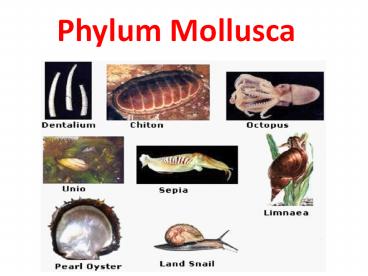Phylum Mollusca - PowerPoint PPT Presentation
1 / 14
Title:
Phylum Mollusca
Description:
Phylum Mollusca Squid External View Squid Internal Anatomy Assignment: Complete Phylum Mollusca handout from last class With your partner, read over the handout for ... – PowerPoint PPT presentation
Number of Views:124
Avg rating:3.0/5.0
Title: Phylum Mollusca
1
Phylum Mollusca
2
Phylum level Characteristics
- soft-bodied with single muscular foot
- internal or external limestone shell
- complete digestive system
- coelomates
- grouped together because of similar developmental
patterns - live everywhere
- ocean, freshwater, on land
3
General Body Plan
- Foot
- Mantle
- tissue that hangs or covers some or all of the
body - Shell
- hard structure can be internal or external
- Visceral mass
- contains all internal organs
- Radula
- unique to mollusks
- its a rasping organ with file like teeth to
scrape, crush food - Gills
- to extract oxygen from water and can filter food
4
Feeding
- Every form of feeding is represented by the
various types of mollusks - Some utilize a radula
- Herbivores use it to scrape algae off surfaces
- Carnivores us it to drill into the shells of prey
- Octopi and sea slugs produce poison to subdue
prey then use sharp jaws to eat them - Filter feeders use gills to sift food from the
water - slug video
5
Respiration
- Aquatic species use gills (found within the
mantle cavity) to extract dissolved oxygen from
the water - Land molluscs breathe via an adapted mantle
cavity lined with blood vessels. Must be kept
moist for oxygen to enter the cells
6
Circulatory System
- Slow moving or sessile species have an open
circulatory system - Blood not always within blood vessels
- Works through body tissues in open spaces called
sinuses - Faster movies species (like octopi) have a closed
circulatory system - Blood always within vessels
- More efficient
7
Excretory System
- Complete digestive system
- Solid waste expelled through anus
- Metabolic wastes (ammonia) excreted by nephridia
(simple kidney like organs) - Nephridia remove wastes and excrete to outside
through skin
8
Nervous System
- Varies greatly between species
- Bi-valves have extremely simple systems
consisting of a couple ganglia, nerve chords and
sense organs - Octopi and other complex molluscs have developed
brains with memory and learning capacity
9
Reproduction
- Again, varies between species
- Most have separate sexes and fertilization is
external (in open water) - More complex species have internal fertilization
10
Ecological Economic Importance
- clams, oysters, scallops all farmed or fished for
food - octopus some food value, recreational diving to
observe
11
3 Main Classes
- Take some time to read over pages 590 592 to
learn about the - Gastropods
- Bivalves
- Cephalopods
- Complete Phylum Mollusca handout
12
Squid External View
13
Squid Internal Anatomy
14
Assignment
- Complete Phylum Mollusca handout from last class
- With your partner, read over the handout for
tomorrows dissection - Begin to fill in as much of the handout as you
can.































